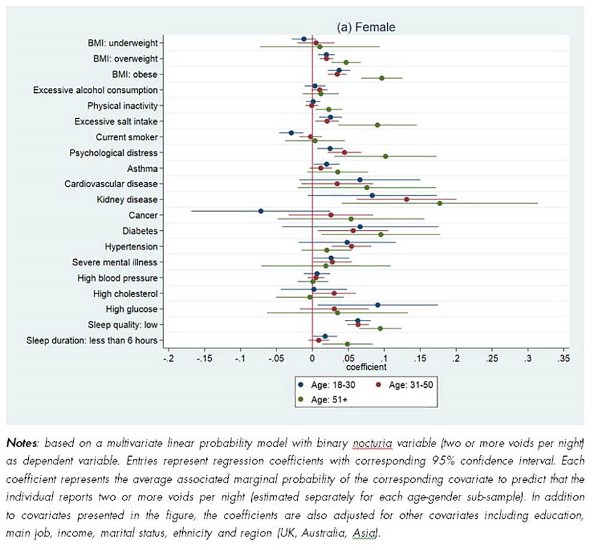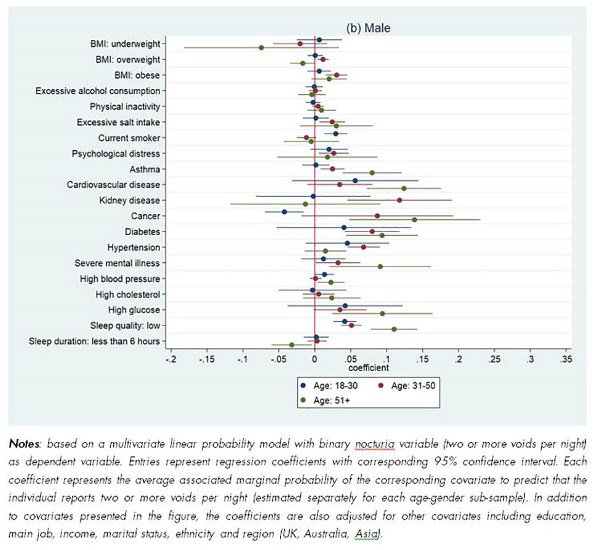Hypothesis / Aims of study
Nocturia is defined by the International Continence Society as ‘the complaint that the individual has to wake at night one or more times to void. Previous analyses, mainly based on older populations, have investigated the link between nocturia and lifestyle behaviours as well as co-morbidities. However, there is a relative paucity of evidence with regards to nocturia in a working population. This observational study examines the relative importance of the link between nocturia and a range of lifestyle behaviours and co-morbidities, as well as self-reported quality of life (QoL) and workplace productivity in a working population aged 18 or above.
Study design, materials and methods
The study is the largest prospective observational surveys on nocturia in a working-age population, covering seven countries, including the United Kingdom, Australia, Singapore, Malaysia, Thailand, Hong Kong and Sri Lanka. An online survey covering a wide range of health and well-being questions was conducted. Across two years, 2017 and 2018, the study had more than 93,000 participants. We use multivariate regression models to investigate the associations between nocturia and a set of factors and co-morbidities. The study also investigates the link between nocturia and a set of sleep quality measures. The link between nocturia, QoL and work impairment using the Work Productivity and Activity Impairment (WPAI) questionnaire is examined, unadjusted and adjusted for a large number of confounding factors, including sleep quality and duration. All statistical analyses are conducted in STATA 15 and results presented with a significance p-value of 0.05.
Results
10 percent of survey respondents report two or more voids per night (UK: 9.7%, Asia: 11.2 %, Australia: 10%) with age and gender distributions as follows across respondents:
Survey participants are asked about the level of bother of getting up at night to void. We find a statistically significant bother threshold of two or more voids per night. For age cohorts above 31 years old, a quarter or more of respondents report significant bother from going to the bathroom at least twice nightly. This increases with nocturia symptom severity.
Adjusted for a large number of covariates, including socio-demographics, lifestyle factors as well as chronic health conditions, we find that across all age cohorts nocturia is statistically significantly associated with higher levels of sleep disturbance (lower overall sleep quality and shorter FUSP – First Uninterrupted Sleep Period) and daytime fatigue, with sleep disturbance increasing with nocturia symptom-severity.
Nocturia is associated with a range of chronic health conditions and lifestyle factors. Depending on age and gender grouping (see Figures 1 and 2), some of the strongest predictors of nocturia are:
Lastly, adjusted for many covariates – including sleep duration and sleep quality – nocturia is associated with: statistically significant reduction in QoL (1.9% for two or more voids compared to less than two voids per night; p<0.0001) and: work impairment due to absenteeism and presenteeism (3.03% impairment for two or more voids compared less than two voids per night; p<0.0001), which similar in magnitude to other chronic conditions such as asthma or kidney disease. The level of reported work impairment is larger for younger cohorts (aged 18 to 51) than for older cohorts (51 or older).
Interpretation of results
A substantial proportion of the working-age population across seven countries experiences the impact of nocturia. The survey data confirms that nocturia is a bothersome condition, validating two or more voids per night as a statistically significant threshold, irrespective of the age of the studied population. By identifying the strongest predictors of nocturia, grouped by age and gender in a large multi-country population, this study helps advance the understanding of the non-lower urinary tract variables and domains involved in the causal pathway of nocturia as well as the weighted probability of their association. The empirical evidence provided in the study adds further knowledge regarding different domains on how to diagnose nocturia patients across different age cohorts.
The study also shows strong associations and overlaps between nocturia and sleep quality, which suggest that the consequences of nocturia are partially explained by poor sleep, but there remains an substantial independent effect of nocturia on work impairment. Given its sleep impairing effect nocturia has a strong negative effect on work productivity and hence is associated with substantial economic cost for employers and the wider society.
Concluding message
This study underscores the importance of nocturia in a working population and its associated co-morbidities, and negative ramifications with regard to sleep disturbance and workplace productivity. Given the substantial health and wellbeing and economic implications of untreated nocturia, this study provides helpful evidence to health-care providers and employers – of the importance of identifying and treating nocturia. While this study shows independent effects of nocturia, even after controlling for other sleep disturbance covariates, with the data available it cannot fully tease apart the directionality of the relationship between nocturia and sleep, which is an important area for future research.

Figure 1: Associations between demographic and lifestyle factors, co-morbidities and nocturia, by age – marginal probabilities (female sample)

Figure 2: Associations between demographic and lifestyle factors, co-morbidities and nocturia, by age –marginal probabilities (male sample)
Disclosures
Funding This study was funded by Ferring Pharmaceuticals, Copenhagen, Denmark. The authors certify that they have no financial involvement in any organization or entity with a direct financial interest in the subject matter or materials discussed in this abstract, although FA and TB are employees of the sponsor. MH and CvS are from RAND Europe, an independent, not-for-profit research organisation. The authors have no other conflicts of interest directly relevant to the content of this abstract.
Clinical Trial No
Subjects None